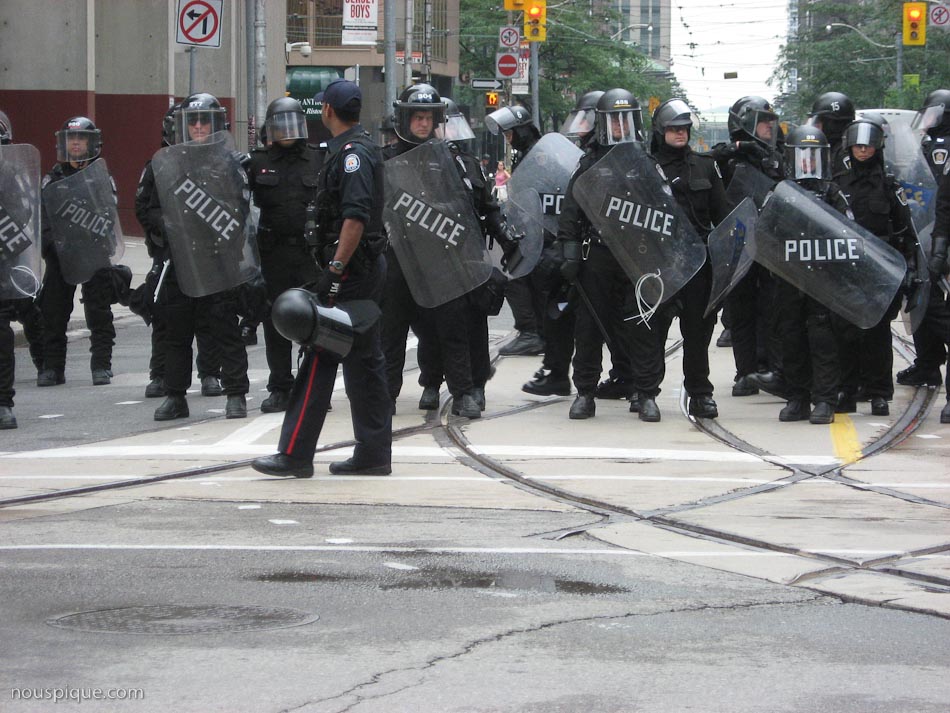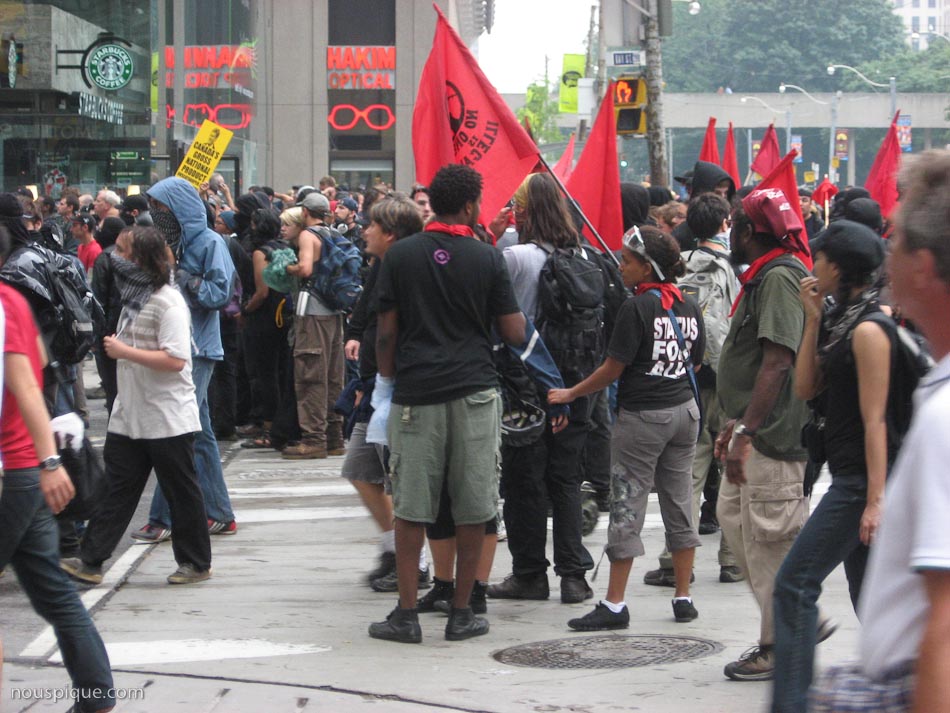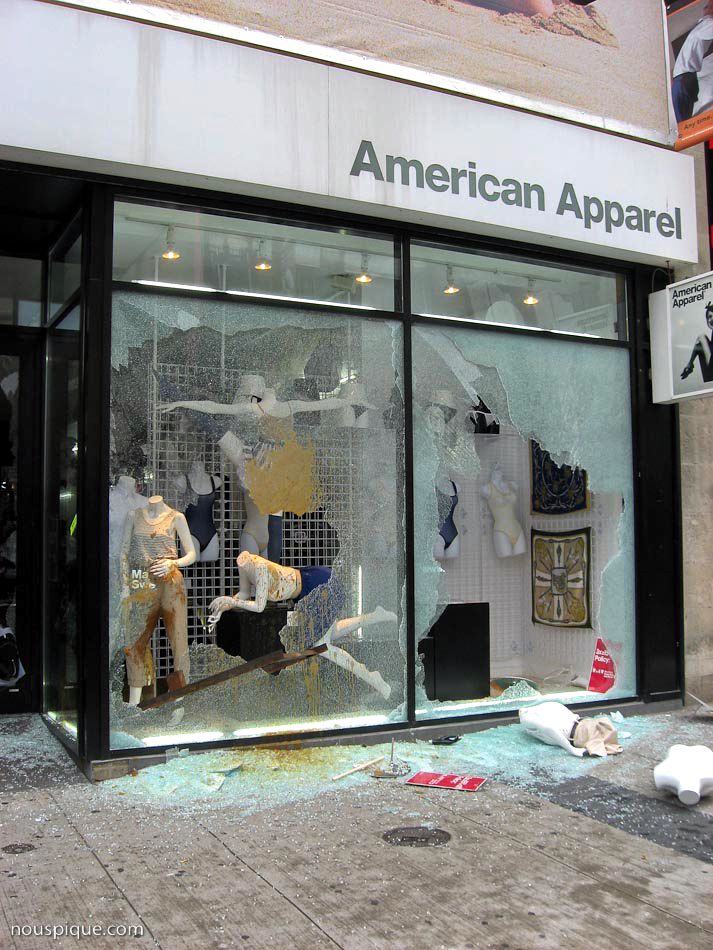On Friday June 25, 2010, the day before the G20 Summit, I accompanied my wife to her place of work on the northern limit of the secured zone in Downtown Toronto. I went partly out of concern for her and partly out of curiosity. After saying good-bye to my wife, I walked east along Wellington St. to Yonge St. where a police officer asked me for ID. I was well away from the security perimeter but had heard rumours of expanded police powers so I complied, assuming that the officer was acting within the scope of his authority.
Later, while wandering around, private security guards asked me to move along and told me I couldn’t photograph the building they were guarding. And later still, when I returned to meet my wife at the end of her work day, I was again asked for ID and questioned about both my reason for being there and the contents of my bag. After being vetted by the police officer, I sat on the steps to the building where my wife works and was again accosted by private security guards.
On Saturday June 26, 2010, my wife and I attended a peaceful rally at Queen’s Park. Meanwhile, a couple kilometers to the south, the leaders of the G20 nations were meeting to engage in economic planning that will affect virtually every living creature on the planet. Later in the afternoon, we found ourselves at the intersection of Queen St. W. and Bay St. when young people dressed in black erupted in a window-smashing frenzy.
All that is done now, but I am still bewildered, wondering what has happened to this city. Typically, I would describe myself as an issues person, but I have had little time to consider the issues that were formally addressed at the Summit because of all that has happened on the ground. For me, what is vital now is the local; the global will have to wait.
Protesting the G20 Summit is a worthy enterprise. People who wish to engage their constitutionally protected rights of assembly and free speech can find all kinds of reasons to speak out. Some of those reasons are substantive; they relate to issues being addressed by the G20 leaders:
- Banking. Tax banks? The Tobin tax?
- Monetary Policy. Austerity or Stimulus?
- Trade. Liberalization? Barriers?
- Environment. Sustainability? Greenhouse Emission caps? Cap ‘n Trade?
- Military. Iraq, Iran, Afghanistan, Gaza, Darfur, Kyrgystan, Tibet, North Korea?
- Human Rights. Well, okay, maybe they didn’t talk about human rights.
But other reasons to protest are best described as procedural. These are local and particular to the way in which the G20 Summit was implemented in this place.
- The disruption of a major urban centre.
- Extraordinary security costs and concerns about pork barrel policing.
- Temporary suspension of civil liberties through secret regulations.
- Enforcement of non-existent laws.
- Use of agent provocateurs.
- Police brutality.
- The abandonment of ordinary citizens for the sake of a select few.
The two strands of protest set up a dissonance that typifies the growing proliferation of international gatherings that consider global agendas. It is the dissonance between the macro and the micro, the global and the local, wealth and poverty, power and vulnerability. The most important question of those who protest global events is: how can we most effectively resist their agendas?
A question on the ground in Toronto is: do Black Bloc tactics further the aims of resistance?
Having been caught in the midst of their actions and having witnessed firsthand the damage that they did, I’m taken aback by the reportage in mainstream media. For example, we have this article in the Globe & Mail from Christie Blatchford (who was never there) which accepts at face value the claims of the police chief Bill Blair that protesters interrupted a soldier’s funeral cortège when there is independent evidence [YouTube video removed] to suggest that he is lying—or at least to warrant the kind of independent investigation that is supposed to be the hallmark of good journalism. Frankly, Blatchford is talking out her ass. More generally, our mainstream media have vilified a little bit of window-smashing at the expense of more important issues. These people are characterized as “thugs” and “hooligans” and “anarchists” who are using the event as an excuse to go wild.
Maybe the media are talking about other people. I witnessed something different. What I witnessed were well-organized people who were focused and had a clear message to deliver. They were not random. They were not crazed hooligans. Contrary to claims by mainstream media, they did not hurt Toronto’s small business operators (unless you include the Zanzibar strip club in that description). What I witnessed was a group of people striking out at symbols of power and oppression—banks, international brands, garment retailers engaged in questionable labour practices, big media concerns, and (of course) law enforcement.
As a citizen of this rather staid city, I am offended by smashed windows. But when I step back and think for a minute, I wonder if maybe there’s something wrong with my own attitude. The fact is: I agree with the protesters in black. I don’t like the banks either. They are what Ed Broadbent used to call “corporate welfare bums.” And with the G20, Stephen Harper has ensured that not only our domestic banks, but banks throughout the world, continue to get a free ride. I don’t like garment retailers that don’t give a shit about labour practices in Bangladesh, or claim to give a shit but engage in questionable practices at home. I don’t like fast food vendors who rely on meat raised in deplorable conditions which is purchased like any other commodity in an international market. And as for the allegations about interrupting the repatriation cortège. If it had really happened, then, yeah, it would have been rude and insensitive. But dammit! I’m opposed to troops in Afghanistan. And no, I won’t feel compelled to show respect in death for someone I would not have respected in life. After all, we’re talking about trained killers here.
On substantive points, I find myself sympathizing with the people we’ve come to identify as the Black Bloc. My disagreement is more with the procedural points. Again, stepping back, I’m not so sure a few smashed windows is as distressing as people make it out to be. Their methods are rational. They can be understood and analysed. The same cannot be said for the police who, on many occasions, threw reason out the window. When they implemented “kettling” procedures, they told people they would be arrested if they didn’t leave, yet denied them a way to leave. This was documented by no less than Steve Paikin of TVO. Police Chief Bill Blair deliberately withheld the fact that he had misinterpreted regulations expanding police powers because he “was trying to keep the criminals out.” This is lying by omission. These breaches of public trust represent a far deeper betrayal than a few strategically smashed windows.
But what disturbs me more than Black Bloc tactics or duplicitous and incoherent law enforcement is the utter complacency of Toronto’s citizens. It appalls me that people would express more outrage at a few broken windows than at the suspension of constitutionally guaranteed rights and freedoms. The problem with Toronto is that the very thing which makes it great—its tolerance—looks a lot like the very thing which makes it weak—its complacency. Toronto is a flaccid city bloated with middle class denizens who are disengaged from the issues that affect them because they’re too goddammed comfortable. I include myself in that description. We’d rather switch off our minds with entertainment than trouble them with issues.
Traditionally, Toronto has described itself as Toronto the Good. Sometimes, people behave as if being good is the same as being nice or insipid. But being good is something altogether different. Being good can mean being filled with righteous anger. Bruce Cockburn’s “If I had a rocket launcher” captures this attitude. And the tolerance we celebrate during Pride week represents the culmination of a thousand small acts of righteous anger. This aggressive goodness has its roots in the Judeo-Christian tradition. Moses committed homicide. Jesus lost his temper in Jerusalem’s temple. Both acts were grounded in righteous anger at the abuse of power.
Despite my ability to rationalize just about anything—including window-smashing rampages through the streets of Toronto—I don’t see myself putting on black clothes and covering my face any time soon. Here’s why:

One of the cautionary questions any activist should ask is this: how am I being used? Whether the action is as innocuous as retweeting, or as serious as torching a police car, it is important to anticipate how media, police, politicians—even other activists—will interpret what you do. Power, especially the power inherent in media, includes the power to manipulate perception. Look at the way Christie Blatchford has helped to characterize protesters in black as insensitive uncaring pricks. And media interviews with sweet elderly vets who have lived all their lives in Toronto and have served overseas to defend the freedoms we enjoy … anybody who questions such treacly spin must be a thick-skinned asshole. Never mind that the streets he cries out for are almost universally owned by companies listed on major stock exchanges. His tears are years too late. The battle for his city was lost when he was a younger man. Apple won. So did Scotiabank and Cara Operations Limited and NRDC Equity Partners (U.S. owner of The Bay).
We have heard the obvious ways in which Black Bloc protesters may have been used. It has been suggested that police allowed them to rampage through downtown Toronto. There is speculation that this was a strategic move which garnered sufficient public support that police could then exceed their authority without question. In addition, it would deflect criticism from the PMO regarding the enormous security costs. While activists like Craig Kielberger have said that the Black Bloc draw attention away from legitimate groups, that may be precisely the outcome authorities were hoping to achieve by withdrawing the police presence from Yonge St.
But there may be other ways the Black Bloc protesters have allowed themselves to be used, more subtle than those discussed by mainstream media. It may be that these protesters have unwittingly internalized modes of expression that mirror the very behaviours they lash out against. I raise a few examples here. Perhaps these will be the seeds for a more developed discussion at a later date.
Has Black Bloc become a brand?
Were the Toronto participants a franchise of a globally recognizable method? Are they marketing a product?—a particular brand of civil disobedience? Think of the clothes. The look. The code words. Is there anything to distinguish them from kids at the Gap or West 49?

Are Black Bloc methods acontextual?
They parachute into a scene and implement their tactics without regard for local culture or the nuance of place. Isn’t that what global brands do? Isn’t that what the G20 group has done to the City of Toronto? Citizens have complained that the heightened police presence and barricades are inappropriate to this place; this is not how we do things here. And yet we’ve been compelled to fall in step with orders from somewhere else. This global event has imposed on Toronto a decontextualized model of how a Summit ought to be run. But the same is true of the Black Bloc people. They are committing the very evils of those they protest. They come here with their violence and their confrontation and run roughshod over a long tradition of peaceful assembly and conciliatory public discussion that is particular to this place.
Black Bloc methods end up being nothing more than McProtest. Next year they’ll go to France and pull the same ready-made methods from the same plastic box.
Does Black Bloc mimic big media?
It’s almost as if the Black Bloc people were making a ratings grab, trying to steal attention from other, more staid, protests. How does Black Bloc distinguish itself from big-media trash-talkers who prefer spectacle to reason. Shock media is a one-off stunt, but it takes you nowhere if you can’t follow up with substance. Otherwise, it becomes as trivial as the 11 o’clock news which we’ve already forgotten by 11:35.
What about anonymity?
Avoidance of responsibility is a hallmark of power. From the highest echelon to the police officer wearing riot gear, the chant is the same: “We were just doing our job.” People demand police badge numbers and the officers respond with the phone number for Pizza Pizza. This business of blending with the everyone else. Isn’t that a page ripped from the police handbook, with agent provocateurs who wear pictures of Che Guevara on their knapsacks? In discussing new media, Jaron Lanier has noted that anonymity with social media contributes to the degradation and trivialization of public discourse; it undermines healthy democracy. The same is true of anonymity in public protest. Black Bloc is to city streets what trolls are to comment pages.
Even if we assume that the protests of those using Black Bloc techniques were real, and their violence was not precipitated by agent provocateurs, it’s difficult to see how they have distinguished themselves from the entities they claim to critique. Maybe that in itself is evidence that this kind of protest is not real. It is manufactured. It is manipulative (and therefore easily manipulated). It is these things because it lacks the imagination to distinguish itself. You’ve probably seen the banner: “Another world is possible.” Yes. Another world is possible. But such a claim requires sufficient imagination to point the way. Smashing things — whether committed by protesters or by agents of the state — is a craven act that offers us nothing.
